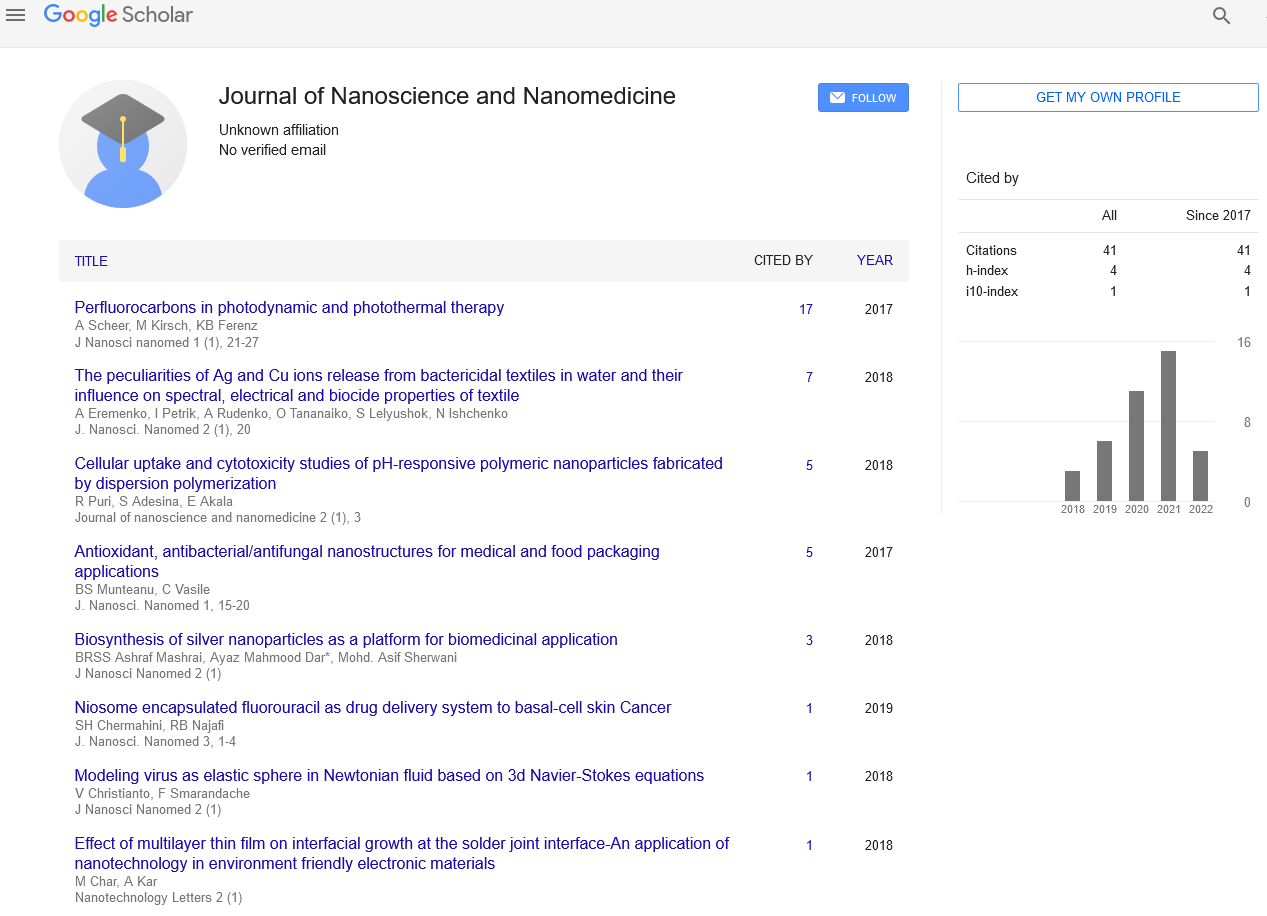Nanoparticle applications in biology and medicine
Received: 04-Jan-2022, Manuscript No. PULJNN-22-4500; Editor assigned: 06-Jan-2022, Pre QC No. PULJNN-22-4500 (PQ); Reviewed: 20-Jan-2022 QC No. PULJNN-22-4500 (Q); Revised: 20-Jan-2022, Manuscript No. PULJNN-22-4500 (R); Published: 27-Jan-2022, DOI: 10.37532/puljnn.22.6(1).06-07
Citation: Greece N. Nanoparticle applications in biology and medicine. J Nanosci Nanomed. 2022;6(1):6-7
This open-access article is distributed under the terms of the Creative Commons Attribution Non-Commercial License (CC BY-NC) (http://creativecommons.org/licenses/by-nc/4.0/), which permits reuse, distribution and reproduction of the article, provided that the original work is properly cited and the reuse is restricted to noncommercial purposes. For commercial reuse, contact reprints@pulsus.com
Abstract
Nanomaterials are at the forefront of nanotechnology's constantly evolving sector. These materials are outstanding and necessary in many areas of human activity due to their unique size-dependent characteristics. This brief study attempts to summarise recent advances in the field of applied nanomaterials, with a focus on their use in biology and medicine, as well as their commercialization potential
Keywords
Nanomaterial; Nanotechnology; Tissue engineering; Hyperthermia; Phagokinetic
INTRODUCTION
Nanotechnology is a technology that works with items as small as nanometers. Nanotechnology is projected to evolve on various levels, including materials, devices, and systems. Nanomaterials are now the most advanced, both in terms of scientific understanding and commercial uses. Nanoparticles were first examined a decade ago due to their size-dependent physical and chemical characteristics. They are now in the commercial exploration phase. Cells in living animals are generally 10 metres in diameter. The cell pieces,
on the other hand, are significantly smaller, measuring in the sub-micron range. Proteins are even smaller, with a mean size of just 5 nm, equal to the dimensions of the tiniest artificial nanoparticles. This basic size comparison suggests that nanoparticles might be used as extremely small probes to see cellular machinery without causing too much interference. Nanotechnology progress is fueled by a deep understanding of biological processes at the nanoscale level. The goal of this study is to provide readers with a historical perspective on nanomaterial applications in biology and medicine, as well as an overview of recent discoveries in the field and a discussion of the difficult route to commercialization. Bionanomaterial hybrids can also be used to create new electrical, optoelectronic, and memory devices .This, however, will not be explored in this article and will be the subject of a later post [1].
Applications
The following is a list of some of the uses of nanoparticles in biology and medicine:
- Fluorescent biological labels
- Drug and gene delivery
- Pathogen bio-detection
- Proteomic detection
- DNA structure investigation
- Tissue engineering is a technique for modifying tissue
- Hyperthermia (heating) destroys tumors
- Biological molecule and cell separation and purification
- MRI contrast enhancement
- Phagokinetic investigations absorption
RECENT DEVELOPMENTS
Tissue engineering
The surface of natural bone frequently has 100-nanometer-wide structures. The body would try to reject an artificial bone implant if the surface was left smooth. Because of the smooth surface, a fibrous tissue covering the implant's surface is likely to develop. This layer limits the amount of bone-implant contact, which might lead to the implant loosening and additional inflammation. It was shown that adding nano-sized structures on the surface of a hip or knee prosthesis might lower the likelihood of rejection while also stimulating the creation of osteoblasts. On the advancing surface of the bone, osteoblasts are the cells that are responsible for the development of the bone matrix [3].
Cancer treatment
Photodynamic cancer treatment is based on the cytotoxic death of cancer cells using laser-generated atomic oxygen. When compared to healthy tissue, cancer cells take in a higher amount of a particular dye that is used to produce atomic oxygen. As a result, only cancer cells are eliminated before being exposed to laser radiation. Unfortunately, the residual dye molecules move to the patient's skin and eyes, making him or her very sensitive to sun exposure. It's possible that this impact will linger for up to six weeks [4]
Cell and biomolecule manipulation
Functionalized magnetic nanoparticles offer a wide range of uses, including cell separation and probing, as outlined in a recent study. The majority of magnetic particles investigated so far are spherical, which limits the options for making multifunctional nanoparticles. Metal electrodeposition onto a nanoporous alumina template can be used to make alternative cylindrically shaped nanoparticles. Nanocylinder radiuses can range from 5 to 500 nm, with lengths up to 60 m, depending on the template parameters. Individual cylinders' structure and magnetic characteristics may be fine-tuned by successively depositing varied thicknesses of different metals [5].
PERSPECTIVES FOR THE FUTURE
Currently, medication delivery is the focus of the bulk of commercial nanoparticle uses in medicine. Nanoparticles are replacing organic dyes in biosciences applications that demand excellent photo-stability and multiplexing capabilities. There has been some advancement in the direction and remote control of nano-probe functions, such as driving magnetic nanoparticles to the tumour and then either releasing the drug load or just heating them to kill the surrounding tissue. The main tendency in nanomaterial development is to make them multifunctional and programmable by external signals or the local environment, thereby transforming them into nano-devices.
REFERENCES
- Murray CB, Kagan CR, Bawendi MG. Synthesis and characterisation of monodisperse nanocrystals and close-packed nanocrystal assemblies. Annu Rev Mater Sci.2000;30:545-610.
Google Scholar Cross Ref - Mazzola L. Commercializing nanotechnology. Nature Biotechnology.2003;21:1137-1143.
Google Scholar Cross Ref - Paull R, Wolfe J, Hebert P et al. Investing in nanotechnology. Nature Biotechnology.2003;21:1134-1147.
Google Scholar Cross Ref - Taton TA. Nanostructures as tailored biological probes. Trends Biotechnol.2002;20:277-279.
Google Scholar Cross Ref - Whitesides GM. The 'right' size in Nanobiotechnology. Biotechnology Nature2003;21:1161-1165.
Google Scholar Cross Ref





